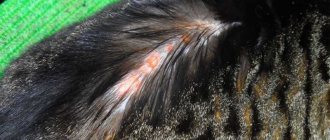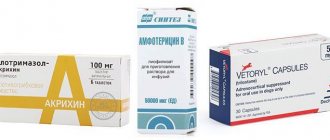Flea dermatitis in cats is one of the most common problems faced by lovers of these animals and from which not a single pet, even a carefully groomed pet, is immune. A similar reaction occurs as a result of an allergy to substances contained in the saliva of blood-sucking parasites. The initial manifestations of the disease can be noticed within ten to fifteen days after the flea bite, and the insects themselves may no longer be on the animal’s body by this time. It has been noticed that a cat with hypersensitive skin can react with a case of dermatitis after just two, or even one, flea bite. In this case, it is necessary to begin treatment immediately before the disease spreads to large areas of the body.
What is flea dermatitis?
Dermatitis is manifested by inflammation of the skin resulting from exposure to an irritant, that is, they are considered allergic diseases. For flea dermatitis to occur, it is not at all necessary that the pet be covered in fleas, since a couple of bites from random insects are often enough for its development. Young cats between nine months and three years of age, as well as those with short hair or hairless breeds, are considered to be most sensitive to such a reaction.
Up to two dozen different allergens can be simultaneously present in a flea's saliva, one of which is likely to lead to an allergic reaction.
The disease develops as follows:
- flea saliva containing the allergen after a bite gets on the skin or under the skin of the cat;
- the allergen penetrates the layers of the epidermis;
- subsequently it penetrates into the lymph;
- Together with the lymph, the allergen spreads throughout the animal’s body;
- in response, cells of the immune system initiate a protective reaction.
It has been noticed that manifestations of dermatitis occur not only at the internal level; quite quickly they also manifest themselves in the form of external rashes, which quickly progress and, if urgent measures are not taken, cause significant discomfort to the cat and even change its behavior.
Why does dermatitis develop?
Fleas are a nuisance to absolutely all animals, especially domestic ones. Even if your pet does not go outside, the risk of becoming a target for flea dermatitis remains. The cat comes into contact with the soles of shoes, outerwear, strangers in your home, and so on. And fleas are very tenacious, so they can easily enter the house along with foreign objects. Contact with street animals is especially dangerous.
Fleas do not live permanently on a cat. In thick wool they only feed and then spread throughout the apartment. You can find them in large concentrations under cabinets, sofas, and in carpets. These insects have a rather complex development cycle, which covers several phases at once. Fleas begin to develop from an egg, and the process ends with an adult, which will receive nutrition from the pet’s blood.
You can read more about the development and lifestyle of a cat flea and how to get rid of it in a special article on our portal.
Fleas do not live permanently on cats
Symptoms of flea dermatitis in cats
An allergic reaction caused by flea dermatitis cannot have a long latent period; diseases of this kind appear quickly and are quite pronounced.
The cat's behavior will begin to change, it will become restless, and upon careful examination of your pet, you can find the following:
- severe itching in a cat causes the animal to constantly itch; scratching in certain places with rashes can merge into limited weeping areas;
- changes in character are noticeable, the cat becomes restless, nervous, and may lose interest in food;
- in areas with rashes, hair loss, deep scratches and redness are observed;
- fleas and traces of their vital activity in the form of dark feces can be found on the skin;
- the rapid development of the disease leads to the formation of scabs in areas of scratching;
- the addition of a secondary infection threatens inflammation with purulent discharge.
A disease such as flea dermatitis can have an acute form, which can become chronic. The most affected areas of the skin are those located on the abdomen, around the ears, and on the back, and they tend to increase and gradually cover more and more new areas. If dermatitis occurs in a chronic form, then exacerbations of the disease are most often observed in the summer.
General symptoms of dermatitis in dogs
The first thing the owner needs to look at is the behavior of the pet. Why is it worth observing other than skin signs? As previously mentioned in the article, skin characteristics are purely individual. That is why allergic inflammation of the dermis can vary equally among different breeds.
If in an animal with delicate skin redness occurs immediately after a flea bite, then in an animal with rougher skin, an allergy to the enzymes contained in saliva may occur much later. Thus, the first priority is to observe the animal's behavior.
Pet owners need to know the main symptoms of flea dermatitis
This is important in order to start therapy in a timely manner. These include:
- painful itching, which leads to the need to constantly scratch the surface of the skin;
- baldness in areas where scratching occurs;
- anxiety in dogs and cats.
If there is serious damage to the body, then the animal may experience:
- vomit;
- lack of interest in food;
- indigestion.
Dermatitis in dogs can be of several types, however, no matter which of them is diagnosed at the moment, all have common symptoms that do not depend on the causes of development. These signs are:
- the animal experiences pain in the affected area of the dermis, itching;
- at the site of direct damage, the temperature of this part of the body rises;
- redness of the dermis in areas of scratching and injury;
- slight bleeding is possible, followed by the formation of thin, dried blood;
- the development of traumatic edema, followed by the inflammatory process and skin changes.
In the absence of timely treatment, the disease develops into a chronic form, when the subcutaneous tissue and the dermis itself swell, and the hair falls out.
The main symptoms that indicate flea dermatitis:
- severe itching that the animal feels;
- numerous wounds due to the dog scratching and biting the skin;
- hair falling out, bald patches appearing on the body;
- lack of appetite, stomach problems, vomiting;
- inappropriate behavior, irritability, frequent whining or barking.
An allergic reaction due to frequent flea bites can be immediate or delayed. An immediate reaction will be observed only in dogs with hypersensitive skin, but there are many fewer of them, and therefore the majority have a delayed reaction to numerous bites.
That is why dermatitis becomes noticeable already at the level of its intensive growth.
Dermatitis itself manifests itself as excessive dryness of the skin and the appearance of numerous crusts, papules, and seborrhea. Flea dermatitis can affect the entire body of the animal, but this does not affect the front of the dog's head, ears and feet.
Kinds
Allergic flea dermatitis in cats can occur with varying intensity and some differences in the symptoms shown. Based on these features, the disease is classified into three types:
- Sharp look . Characterized by severe skin itching.
- Subacute appearance . It is an intermediate stage between the acute nature and the transition of the disease to a chronic form.
- Chronic appearance . It is characterized by the formation of nodules on the skin, also accompanied by itching. On damaged skin, hair loss occurs with the appearance of bald areas.
The acute form of flea dermatitis in cats can quickly become chronic, which occurs in the absence of timely treatment or if it is carried out incorrectly. The disease will return until the correct way to eliminate it is found.
Types of disease
Allergies in cats: symptoms and treatment, medications
Dermatitis in cats is divided into two groups: simple - the occurrence of redness and itching upon contact with an external irritant; allergic - a reaction of the body, the response of the immune system to a foreign substance.
Wet dermatitis
Based on the origin of the disease, experts distinguish types of disease:
- bacterial – pathogens streptococci, staphylococci and other pathogenic bacteria;
- contact is the reaction of the skin to contact with external irritants;
- food – an allergic reaction of the body to food;
- parasitic – occurs when the body and organism of an animal are damaged by parasites;
- seborrhea – dermatitis of bacterial origin. It is expressed in keratinization of the skin and the formation of sebum. The first “bell” for the owner about the occurrence of a disease is the appearance of dandruff in the pet;
- Atopic dermatitis is an altered “incorrect” reaction of the immune system to food and other allergy triggers. This type of dermatitis is inherent in animals with a genetic predisposition to it, in cats, with sensitive skin and a tendency to inflammation and rashes;
- Pododermatitis in cats is an inflammation of the skin of the extremities, which results in dry pads, cracks and wounds. The paw begins to bother the animal;
- miliary - rashes of this type of dermatitis are small, similar to scattered millet grains;
- plasmacytic pododermatitis of cats - swelling and enlargement of the animal's paw pads as a result of infection in the plasma cells;
- allergic – the body’s reaction to medications, food additives, flowering plants, environmental degradation, household chemicals, etc.
Who is most susceptible?
Despite the fact that flea dermatitis is considered a fairly common form of allergy and is seasonal, not all animals suffer from this disease. For many of them, flea bites pass without a trace, causing only anxiety from the direct bite and not causing flea dermatitis in the cat. Cat breeds with short hair or completely hairless are more predisposed to such a reaction to substances contained in the saliva of parasites.
Particular attention should be paid to your pets during the warm season; it is during this period that the possibility of flea bites increases. Moreover, for this it is not at all necessary to be on the street; the owners themselves can bring them home on street shoes and infect the pet.
Symptoms: descriptions and photos
All diseases have distinctive signs. Dermatitis in cats is no exception.
Home diagnostics
In most cases, you can identify the presence of fleas in a cat yourself. To do this, you just need to watch your pet for a while.
If you want to make sure that your cat is allergic to fleas, it is recommended to pay attention to the following:
- severe itching, especially in the head and tail area;
- redness;
- blisters;
- swelling at the site of the wound;
- anxiety, mainly at night;
- a cat scratching certain areas until they bleed;
- regular biting (the animal can bite itself).
Fleas are also easy to spot if you carefully examine the fur and skin. The presence of parasites can also be indicated by small black dots - excrement that look like beads.
To find out that this is not just dirt, but flea waste, you just need to dip one of them in a glass of water. If it has dissolved and the liquid has turned a slightly light brown color, you can be sure that the cat is infected.
In cats, a flea allergy has the following symptoms:
- the presence of ulcers or dense nodules;
- excessive dryness of the skin;
- partial swelling in certain places;
- severe scratching (sometimes to the point of bleeding);
- high temperature of certain areas of the skin;
- presence of problems with digestion and appetite;
- excessive fearfulness;
- frequent meowing.
Important: the above signs may be signs of other diseases, so to make an accurate diagnosis and choose the right treatment, you should first consult a veterinarian.
How to diagnose fleas?
Flea dermatitis can be suspected in a cat based on some specific signs that are easy to detect if you pay close attention to it. You just need to take a closer look at the animal and pay attention to changes in its behavior.
If the flea infestation has not yet reached scale and is at the initial stage, then you can check your cat for their presence as follows:
- Place the cat on a clean sheet of white paper.
- Using a comb or brush, comb the animal's fur in different directions.
- Particles of skin, fur, or small black grains resembling dirt may appear on white paper.
- If these particles are crushed, brown or brown marks remain on the paper.
- These particles are flea feces, and the color confirms that the fleas are feeding on the animal's blood.
Such confirmation serves as direct evidence that the cat has fleas, even if there are no other symptoms of infestation. Only a veterinarian can confirm whether their presence is a cause for dermatitis. It is impossible to independently diagnose the flea form of dermatitis, since completely different diseases that do not depend on the presence of skin parasites often exhibit similar symptoms. If, during examination by a specialist, the diagnosis of flea dermatitis is confirmed, then the animal will be prescribed treatment in accordance with the breed and age of the pet, as well as taking into account the form of development of the disease and the degree of damage. Correct prescriptions will not only stop the external manifestation of the disease, but will also prevent its relapses.
Forms of allergies to parasites
Divided into three types:
- acute;
- subacute;
- chronic.
They all have their own characteristics and characteristics, thanks to which the stage can be determined. In the acute form, the disease passes quickly and is accompanied by severe itching, which gives the cat a lot of discomfort. Due to regular combing, the hair may fall off in clumps, and in its place bald areas, often covered with a crust, may appear. With this form of the disease, the cat has parasites in its fur.
If treatment is not started on time, the acute form quickly becomes chronic, which is an intermediate stage between the first and third stages. There may no longer be fleas.
The chronic form is characterized by the presence of signs of both stages. This period of the disease may be accompanied by itching, redness, and then its sudden disappearance. Usually this process is recurrent in nature, because periodically there is an improvement or deterioration in the animal’s condition. The chronic stage is already difficult to respond to medications, so its treatment must be approached comprehensively and only under the supervision of a doctor.
Diagnosis at the veterinarian
If it is difficult to identify the problem yourself, it is advisable to visit a clinic where they will make a diagnosis and determine the stage.
When visiting a doctor, be prepared to provide information about the course of the disease, its main signs and the cat’s behavior. If the inflammation has already started, it will be useful to show the specialist a photo of the initial stage so that he can make an accurate diagnosis. This will allow the doctor to prescribe the correct treatment depending on the animal’s health condition.
A veterinarian can determine the disease in the following ways:
- Technique for combing wool onto white paper . To do this, the doctor uses a comb to remove a scrap from a small area of the cat’s body onto white paper slightly moistened with water. The presence of parasites is indicated by small dark dots around which a spot forms.
- Blood analysis . When this disease is detected in an animal, cells (eosinophils) are found that are involved in hypersensitivity reactions. In this case, their concentration is noticeably increased.
- By visual inspection . As a result, allergies, baldness in certain areas, dried crusts with blood, ear mites, fungal diseases and others may appear.
Photo
As a rule, most cases of flea dermatitis can be easily diagnosed by external signs. If you carefully examine the skin of an animal, it reveals the characteristic manifestations of this skin disease.
So, in a photo taken from the affected area of skin you can see:
- characteristic scratches in the form of bloody deep scratches;
- swelling of the skin with the presence of nodes, blisters, and ulcers;
- areas of skin with excessive dryness;
- redness of the skin with pronounced inflammation;
- purulent discharge may be noticed, which is characteristic of an infection.
Despite the obvious severity of symptoms consistent with the development of flea dermatitis, the final conclusion about the type of disease must be made by a veterinarian. Therefore, treatment of the disease should be carried out under his control and with the help of medications prescribed by him.
Treatment of dermatitis
Drug treatment of flea dermatitis in domestic cats is carried out according to a standard regimen, which involves the use of the following medications:
- drugs with anti-inflammatory effects;
- medicines with antibiotic properties;
- antiphlogistic nonsteroidal drugs.
When treating, you need to focus not only on the choice of medications that can cope with the flea form of dermatitis. It is equally important to create the necessary living conditions for the animal.
Antihistamines
To treat cats with symptoms of flea dermatitis, medications containing calcium sodium thiosulfate and hormones are used. With the help of calcium in the drug, it is possible to reduce vascular permeability, eliminate swelling and reduce itching. However, their disadvantage can be considered some features of application, when their administration involves only intravenous injections, which can only be done by a specialist.
The use of sodium thiosulfate is also carried out only intravenously and strictly in accordance with the prescribed course. Thanks to it, the allergic reaction is stopped, which relieves the cat of disturbing symptoms. Moreover, if you seek help early and start treatment in a timely manner with such a drug, you can completely get rid of allergies.
However, antihistamines occupy a special place in methods of therapy aimed against flea dermatitis. With their help, you can quickly cope with itching, and intended for animals, they do not have a harmful effect on their body. These medications are usually given to your cat for three to five days, after which only your veterinarian can decide whether to continue treatment or stop it. The most effective antihistamine medications for cats are prescribed Suprastin, Tavegil, Diphenhydramine or Zyrtec. Chlorpheniramine, which is taken orally twice a day, 2 ml, copes well with this task.
In some cases, antihistamines are not effective enough against allergies, then it is recommended to treat flea dermatitis using glucocorticosteroids.
Hormonal
Hormonal medications are very often prescribed for severe forms of allergies in animals. Typically, Prednisolone is used for these purposes, starting the course of treatment with a high dose and gradually reducing it. The dosage depends on the weight of the cat and its age, due to which the expected result with the elimination of the symptoms of an allergic reaction occurs in a short time. When carrying out treatment with hormonal drugs, it is necessary to take into account their downside, that is, their adverse effect on the vital processes of the animal’s body. Thus, their use may reduce immunity, disrupt metabolic processes, and complicate the processes of digestion and assimilation of food. It is for this reason that hormonal drugs should be used only if indicated for this type of treatment and not used for a long time.
Often a sick animal is offered local hormonal agents as a cream or ointment. Such a prescription is justified in case of contraindications to the use of systemic drugs.
Treating flea dermatitis at home
Flea dermatitis is difficult to cure at home.
At the first appearance of symptoms, you should consult a veterinarian. He will give the pet injections that contain a glucocorticosteroid component to relieve the symptoms of itching. After using this drug, treatment is carried out at home. How to treat:
- Once every two weeks you need to wash the animal with a special anti-parasitic shampoo. The most popular of them: Phytoelite, Bars.
- Treat your cat's skin with insecticidal cream. Wear special collars. Use flea drops.
- Wet cleaning of the premises using antiparasitic agents.
- Balanced diet.
- Immunomodulatory drugs.
Fighting allergies
For signs of allergies, you can use a strong tincture of chamomile. It will not only relieve itching, but also promote wound healing. You can also use an infusion of string and sage. To eliminate allergy symptoms, brew 1-2 tablespoons of herbs in 1 glass of water. The resulting product is used to treat the pet’s skin.
It is necessary to remove worms, which can also cause an allergic reaction. Antihistamines are used: tablets, suspensions. The following drugs relieve itching well: Septo-spray, Alamicin, Stop-Itching, Suprastin, Tavegil.
Intensive therapy
In its advanced form, flea dermatitis in a cat can cause serious harm to health. Festering wounds in cats can be treated with antibiotics in tablets or injections.
Remedies for flea dermatitis in cats:
- Capstar. It works within an hour after taking the drug. Releases a toxin that kills fleas when they bite an animal's skin. This special drug is used when fleas need to be removed as soon as possible.
- Essential. Eliminate itching and prevent the animal from becoming infected again.
- Stronghold. Helps rid the animal of parasites and eliminates itching within a day. Can be used for kittens from three months.
- Synthesis or Tsamaks. Relieves inflammation, heals wounds.
- Infusion of wormwood or tansy. Used for surface treatment after sterilization of the room and bedding.
If your cat does not improve and symptoms of flea dermatitis persist, you should contact your veterinarian.
Accompanying illnesses
Flea dermatitis in a cat provokes the development of infectious diseases of the skin, which can lead to the death of the pet. If treatment is not timely, the animal may develop an atonic form of the disease, which will torment the animal for the rest of its life. With it, it is only possible to temporarily alleviate the animal’s condition; it cannot be completely cured.
Video - How to give a cat a pill
Often there is a need to treat a pet with tablets and then the question arises: what is the best way to do this?
To do this, you can use the recommendations of specialists or watch the video:
- Carefully study the instructions for the drug and determine the prescribed dosage.
- Decide on the permissibility of giving the medicine with food or dissolved in water.
- Limit the animal's mobility by wrapping it tightly in a thick blanket or towel.
- Raise the cat's head and open its mouth.
- It should be taken into account that the animal will struggle, so it is necessary to hold it still with your free hand.
- By pressing on the lower jaw, it is necessary to open the mouth. Moreover, if you are supposed to give a pill, the mouth must be opened as wide as possible.
- The tablet is inserted with two fingers, trying to get as far as possible to the root of the tongue.
- You must make sure that the tablet is swallowed. To help with this, you can blow lightly into your cat's nostrils, which will trigger the swallowing reflex.
- Release the cat from the blanket and offer it water.
If the animal is strong enough and actively resists, and the fear of inserting fingers into its mouth turns out to be stronger than the desire to help it, then you can insert the tablet using special plastic tweezers, which can be bought at a veterinary pharmacy.
Diet
When relieving a pet of the symptoms of an allergic reaction to flea bites, it is necessary to help the body cope with this change in its condition with the help of special nutrition. Thanks to this, the skin healing process will happen faster, and inflammation and itching will disappear. If the cat eats natural food, then it is necessary to add Omega-3 acid, for example, Nordic naturals Omega.
If you prefer dry ready-made food, it is better to use Royal Canin Skin or Econuba Dermatosis. For a while, it is necessary to give up chicken-based food and not give chicken as food, since it is this type of food that most often contributes to allergies.
Drops
To eliminate the discomfort caused by flea dermatitis in cats, you can use special drops designed for this purpose and approved for the treatment of allergies in animals. In this capacity, veterinarians advise using the following types of liquid preparation:
- Essential 6 - with the help of this product, the animal quickly gets rid of itching, and they also serve as a guarantee to prevent repeated cases of infection. An additional advantage is the packaging with a small dosage;
- Stronghold are drops that can be used for adult cats and kittens from three months of age.
Using these remedies, you can get rid of parasites on the animal’s body within 24 hours, thereby it will stop suffering from itching and anxiety.
Causes of dermatitis
Allergic dermatitis is not only caused by food. Much more often, the cause of dermatitis is various types of parasites that find shelter in cat fur. Each of the insects that settle in a cat's fur coat brings with it a whole collection of allergens.
All secretions of fleas, the most common among representatives of cat insects, are a foreign protein for the cat, penetrating into its body at the sites of bites. And fleas also have a fair amount of bacteria on their paws, each of which can cause allergies. The immune system responds to the penetration of an allergen into the body with a natural reaction visible on the skin - irritation, itching. The cat begins to itch intensely and, as a result of scratching, rashes, swelling and ulcers appear on its body.
- Flea dermatitis is most noticeable in fleas' favorite areas. Most often they bite behind the ears. The base of the tail also suffers from fleas. If a cat begins to itch intensely in these places, this will be the first sign of the appearance of fleas, and with it the occurrence of dermatitis. Most often, flea dermatitis occurs in the warm season, but winter weather does not guarantee against its occurrence.
- Another cause of dermatitis can be subcutaneous mites . They not only bite the cat, but also burrow under its skin. The place where the tick has penetrated first becomes inflamed, then itching appears and a rash appears around the bite. Then the hair begins to fall out actively. Quite quickly, the rash and itching spread throughout the body, and numerous scratches become another way for allergens and infections to enter the cat’s body.
- Many cat owners are unaware that dermatitis can appear in a cat due to infection with worms . Parasites that have settled inside a cat can cause allergies even at the initial stage of infection, and during their life they not only release poisons, but when they die, they also release toxic substances. When treating dermatitis caused by infection with worms, first of all, it is necessary to rid the cat of parasites.
- There are types of allergic dermatitis caused by fungi and bacteria . Only an experienced veterinarian can identify this type of dermatitis and prescribe the correct treatment.
Powder
You can alleviate the condition of an animal when it develops allergic dermatitis as a result of a reaction to flea bites using powder. Most often, powders such as:
- Tsamaks - has wound-healing properties;
- Synthesis - when applied to damaged skin, accelerates its healing, and also effectively relieves inflammation and swelling.
The combination of components in these powders allows you to quickly cope with a problematic situation.
What is the danger of a flea attack?
In addition to the fact that flea dermatitis is a very unpleasant disease, it causes negative consequences in the affected animal. Wounds resulting from flea bites are very itchy; naturally, the animal constantly itches, scratching the skin and tearing out pieces of fur.
It is a proven fact that flea saliva contains 15 substances that are strong allergens for cats. Therefore, it is not surprising that the damaged areas become inflamed and painful. Sometimes other bacteria also get into them, so the risk of developing secondary infections against the background of flea dermatitis increases.
Fleas can “carry” other parasites, including helminths, onto the body of cats. With particularly severe (chronic) infestation, the cat’s immune system is excessively depleted from the constant struggle with “uninvited guests,” and therefore such animals often get sick and have a harder time withstanding any stress. Both the appearance and character of the animal change greatly. The skin is scratched, the fur is dull and faded, coming out in shreds, and the cat himself is nervous and lethargic.
Collar
Using a collar will not get rid of parasites, but it will protect a clean and healthy animal from their penetration. Most often, the following types can be purchased in veterinary pharmacies:
- Leopard - capable of reliably protecting a cat from fleas for seven months, since its characteristic smell repels parasites;
- Baffo - the impregnation of this collar is distinguished by a large number of anti-parasitic components, but they can only be used on animals older than three months.
You should not assume that using a flea collar does not pose any danger to the animal itself. There are cases, however, so far isolated, that the composition used for impregnation can also cause allergies.
Shampoo
As an effective remedy against fleas, special shampoos can be used, which are presented in a large assortment, namely:
- Kiss shampoo - produced in Sweden, it simultaneously kills insects and moisturizes the skin;
- Rolf Club shampoo is a product considered the most effective against fleas, but its more aggressive composition does not allow its use on animals under three months of age.
Many types of shampoos intended for animals, in addition to getting rid of parasites, gently care for the skin, prevent dryness and flaking, and the coat becomes silky and thicker.
Spray
Topical sprays are most suitable for contact allergies and flea dermatitis caused by a reaction to fleas.
- Nartz spray has the advantages of a large volume and the presence of several types of the drug, allowing it to be used in accordance with the age and weight of the animal. It has hypoallergenic properties and can be used from one month of age.
- Front-line spray - due to its sufficient volume, it allows you to extend use up to one and a half years, and one application protects the cat from fleas for up to 40 days.
The use of a spray allows you to relieve the animal from itching and obtain an antibacterial and anti-inflammatory effect.
Signs and symptoms
Photos of dermatitis in cats
Detecting feline dermatitis is a fairly simple task. This is due to the fact that the cat exhibits only two main types of symptoms characteristic of this disease. They are individual for each pet and do not depend on what causes the disease.
- In the first case, there is increased dryness of the skin, on which cracks and scales soon appear. The skin turns red, scratching, rashes and inflammation are observed on its surface. In some situations, the cat's skin becomes covered with ulcers and blisters.
- The second case is characterized by excessively moist and hot skin. Hair falls out on the affected areas. The cat's behavior is accompanied by severe anxiety. This is because dermatitis causes severe itching and burning. It is noteworthy that if two pets are given an identical diagnosis, each will manifest the disease differently. In some cats, the skin only itches a little, while in other cats, the skin is torn off until it bleeds, bald patches form, and the animal suffers greatly.
Treatment of dermatitis in cats must be professional and highly effective. Some pet owners treat their pets themselves. Often, the initial symptoms can go away with self-medication, and the signs of the disease will go away for a while. But this does not mean that you managed to overcome the disease. Most likely, the dermatitis has become chronic.
In the chronic form, symptoms will appear again and again. While it is quite easy to cope with the acute form, it is much more difficult to overcome chronic feline dermatitis.
Kinds
Photo of what dermatitis looks like in cats
Miliary dermatitis in cats is divided into two main groups.
- Simple. This is a group of dermatitis of domestic animals, which includes diseases transmitted through contact with external irritants. The most common irritants are cat collars. Simple dermatitis is a fairly rare occurrence, since the skin is reliably protected from irritants by hair. But the situation is somewhat different with cats of hairless breeds. Judging by the photo, a reaction can occur even to ordinary solar exposure.
- Allergic. An animal can be allergic to a variety of things. The allergic form of the disease is based on inadequate reactions of the immune system to various irritants or foods. An allergy can be food or contact when switching to a new food, using different cosmetics, clothing, or due to contact with allergenic things of the animal owner. Banal repair work or buying new furniture can provoke allergic dermatitis in your pet. The main problem of the allergic form is the difficulty of identifying the allergen that irritates the cat.
Causes of dermatitis
Photograph showing symptoms of dermatitis in cats
Allergic dermatitis in cats can occur not only due to diet or a change in environment. It is important to determine symptoms and treatment by identifying the true cause with your pet's skin.
Much more often, the cause of the disease is parasites and microorganisms that enter the cat’s body. Insects can tolerate many allergens. Plus, their secretions are foreign to the cat, so corresponding skin reactions in the cat’s body usually occur at the bite sites.
The immune system naturally reacts to irritants, causing itching and irritation of the skin. But for this reason, the animal constantly itches, causing the formation of scratching, rashes, swelling and ulcers.
There are several main causes of dermatitis in pets.
- Fleas. The easiest and fastest way to determine if a cat has flea dermatitis. Typically, pests bite in the area behind the ears or the base of the tail. If you notice that these areas of the animal are actively infested, this indicates the presence of fleas. As a result, the likelihood of dermatitis is high. Most often, flea disease occurs in the summer.
- Ticks. Another common cause of feline dermatitis is subcutaneous mites. They bite and penetrate the skin. At the sites of pest penetration, inflammation first occurs, after which they provoke itching and the formation of a rash. Then the animal's fur falls out. The rash and itching can actively spread throughout the body.
- Worms. Not all cat owners know that dermatitis can occur due to the presence of worms in the animal’s body. Parasites release dangerous substances during life and after death during decay. Before treating dermatitis caused by worms, it is imperative to rid the animal of parasites.
- Bacteria and fungi. There is a type of dermatitis caused by bacteria or fungi. Only an experienced veterinarian can identify this type of problem. Only after the examinations have been carried out, the specialist will determine how to treat the animal.
Traditional methods of treating fleas in cats
You can try to alleviate the animal’s condition and treat flea dermatitis in cats at home using traditional methods that will complement the main treatment with medications. To do this, they often use a composition of equal parts of olive and lavender oils and soapy water. Soak a cotton pad in the solution and apply it to the surface of the skin before and immediately after bathing the cat.
The same effect, eliminating irritation and swelling, as well as relieving itching, can be obtained by rubbing with chamomile decoction.
However, if your veterinarian does not recommend using such methods on your animal, then it is better not to use them.
Causes
Cats are unique animals; their saliva contains antibacterial agents. The action of these substances is aimed at healing wounds and cleansing them of pathogenic microorganisms. This is why cats lick scratches and small wounds, preventing the development of various skin diseases.
But if your pet’s immunity has decreased for various reasons or serious damage to the skin has occurred, then you will not be able to cope with the problem on your own.
Irritants will trigger the onset of an inflammatory process, which, in turn, will lead to dermatitis. The type and causes of the disease depend on the irritating source:
- Infectious dermatitis. Infection occurs through a break in the skin. Pathogenic fungi and bacteria penetrate into the wound or scratch. The inflammatory process develops at lightning speed, large areas of the skin become inflamed, and ulcers form on them.
Infectious dermatitis - Parasitic dermatitis. Flea bites, the presence of internal parasites and helminths - all these factors lead to infection of the cat. Parasitic dermatitis affects areas of skin under the tail and behind the ears. In rare cases, in these places, in addition to redness, crusts and wet erosions appear.
Parasitic dermatitis - Allergic dermatitis. This type of disease is divided into two groups - food and contact dermatitis. At first, with each consumption of allergic food, an irritating substance accumulates in the cat’s body. Rejection reactions occur - skin rashes, swelling, hair loss. Contact dermatitis refers to external irritants with an aggressive effect on the animal’s skin. These could be detergents, antiparasitic drugs, household chemicals.
Allergic dermatitis - Traumatic dermatitis. Damage to the skin occurs when rubbing a tight collar, after walking in thorny thickets of grass and in other ordinary situations. Even a small scratch can turn into serious inflammation of the injured area of skin.
- Thermal dermatitis develops when your pet's skin is exposed to high or low temperatures. Dangerous phenomena include direct sunlight in hot weather and frost. Cats often get thermal dermatitis from hot objects.
Dermatitis in cats can also appear after taking medications or fortified preparations.
Accompanying illnesses
Flea dermatitis is dangerous due to its complications, the most common of which are:
- development of atopic dermatitis, ending in the formation of lesions;
- the addition of bacterial infections, accompanied by vomiting, diarrhea and symptoms of fever.
If this happens and the cat’s condition does not improve within a few days, then you should immediately consult a veterinarian. To prevent the development of concomitant diseases and complications, it may be necessary to review and change the prescribed treatment regimen.
Prevention
Today there are no effective remedies that could completely protect against allergies to flea bites. To prevent their pet from suffering from flea dermatitis and its complications, owners must protect it from the possibility of infection.
To do this you should:
- do not allow street walks;
- when traveling to the country, pre-treatment against fleas is necessary;
- in case of high humidity, it is better to reduce walks in the air to a minimum;
- Carry out a thorough monthly inspection of the animal for the presence of fleas, and repeat treatment with drugs that have not expired;
- carry out wet cleaning more often in the room where the cat is;
- treat upholstered furniture and carpets with antiseptic agents;
- When you come home, do not leave dirty shoes in the hallway, but after washing them, put them in the closet.
If your pet has undergone treatment for dermatitis and it was successful, it is recommended that its condition be monitored by a veterinarian for several months. This is necessary for timely action in case of relapse.
How to identify pathology and distinguish it from others
The flea form of the disease is easy to distinguish from other types of dermatitis, since parasites are present. They can be seen with the naked eye. If you have vision problems, you should use glasses or a magnifying glass, since fleas are very small. In the initial stages of the development of the disease, the neck area is affected, so it is necessary to carefully examine this area, carefully moving the hairs apart.
If fleas are not found in one place, this does not mean that they are not found in another. The fact is that in the initial stages of the disease there are very few parasites, so you need to inspect all areas carefully.
If there are fleas, the cat not only itches, but also tries to bite into the skin. If your pet does this regularly, this is a warning sign.











